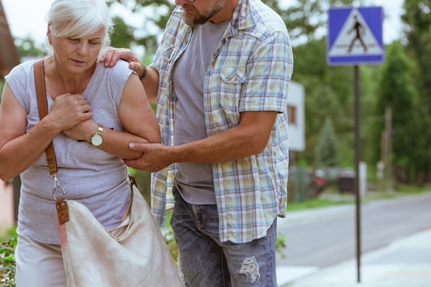
Should I Check for a Pulse?
Surprisingly, it’s recommended you don’t check for a pulse when someone collapses from cardiac arrest. Even if you’re experienced with checking for a pulse, in the heat of the moment, it can be easy to get confused with false pulses. CPR gives the best chance of survival when started right away—checking for a pulse wastes valuable seconds vital to the victim’s survival.
Instead, you should only do two things before starting CPR. First, check for responsiveness from the victim with a shake and a shout. If they don’t respond, call 911, then begin compressions.
How Deep Should My Compressions Go?
For adults—no matter their gender—compressions should be done at 2 to 2.4 inches deep. For young children, compressions should be done at 2 inches or 1/3 of the depth of their chest; for infants, 1½ inches or 1/3 of the depth of their chest.
What If I Break a Rib?
While performing CPR compressions, it’s likely you will hear cracking sounds; this can be the result of connective cartilage or ribs cracking. Of the people who survive with CPR, 30% do so with a broken rib or cracked sternum. However, even if you do feel a bone break or crack, do not stop giving compressions. CPR gives the victim the best chance of survival until trained medical help arrives—it’s better to survive with a broken rib than not survive at all.
While the victim could try to sue you for breaking a rib during CPR, it’s extremely unlikely the case would go anywhere. With a few conditions, the Good Samaritan Law aims to protect bystanders from the legal repercussions of causing unintentional harm during CPR.
Should I Stop Doing CPR If the Victim Gasps?
Gasping after or during cardiac arrest is also called agonal breathing. If the victim is gasping and you haven’t begun compressions, start them immediately—agonal breathing is a sign that the victim’s brain is still alive, but it doesn’t provide enough oxygen. It can be a good sign during CPR, but it isn’t an indication of recovery, and you should continue doing compressions until the victim is revived or until trained medical professionals arrive.
Should I Try CPR If I’m Not Certified?
It’s not illegal to perform CPR if you’re not certified, but you should have an understanding of the basics—compressions should be done hard and fast to the beat of “Stayin’ Alive”—in order to give the victim the best possible chance of survival. Call your emergency number right away, and the 911 operator will walk you through the basic steps of CPR.
That said, people who are trained in CPR are more likely to provide higher-quality life-saving care, giving the victim an even better chance of surviving. If you’re interested in obtaining your CPR certification, schedule a class with Specialized Health and Safety.

